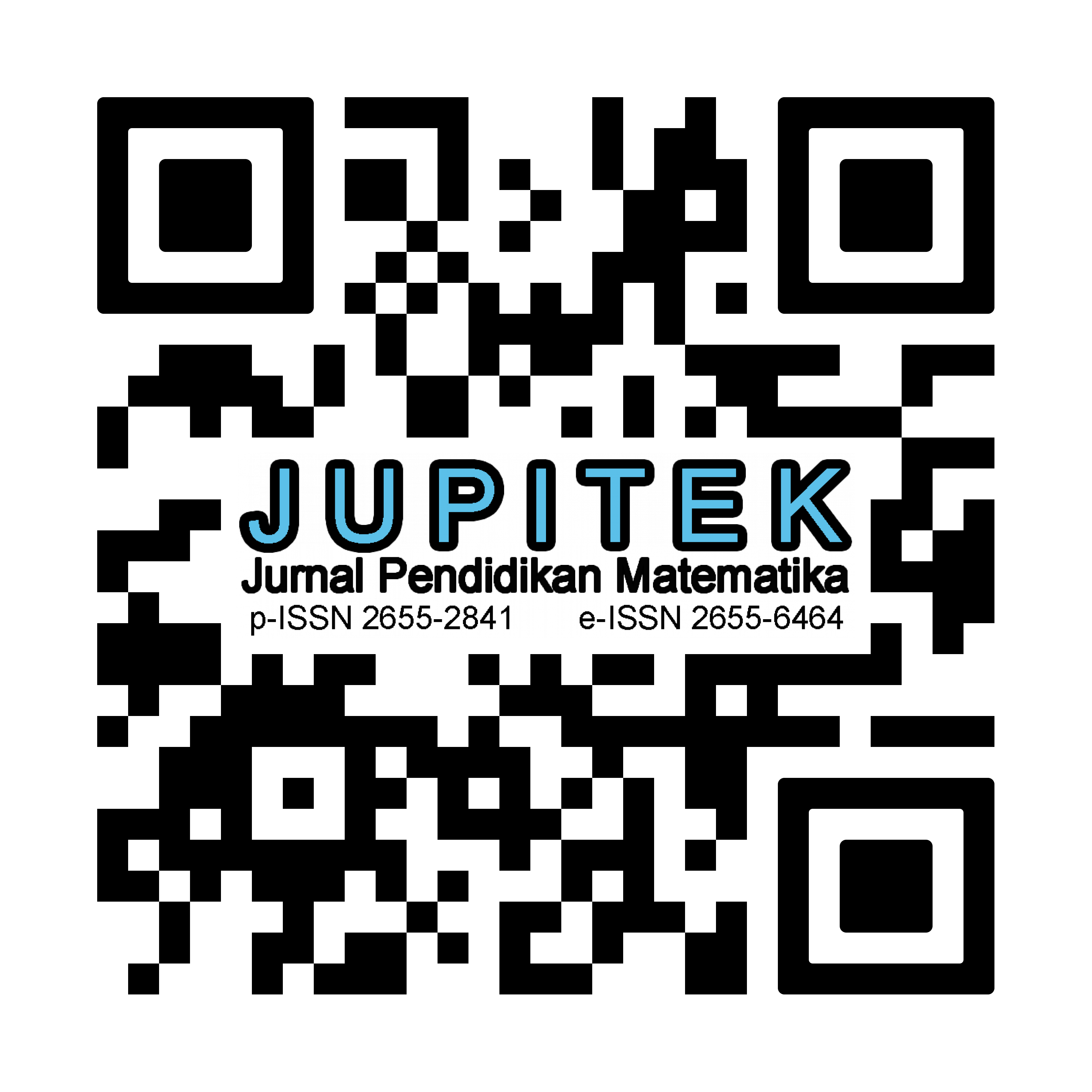LOCAL INSTRUCTIONAL THEORY OF DERIVATIVE TOPICS BASED ON REALISTIC MATHEMATICS EDUCATION FOR GRADE XI SENIOR HIGH SCHOOL STUDENTS
Abstract
This study discusses the development of learning design for derivative topics based on Realistics Mathematics Education (RME). The design developed is different from the designs that have been developed by previous researchers, where in this study, the derivative concept was introduced through the flying fox trajectory, which refers to students' understanding of limits and average velocity. This development aims to obtain a valid, practical, and effective learning design in derivative topics to develop students' mathematical problem-solving abilities. The development model combines the Plomp and Gravemeijer & Cobb models, which are divided into the preliminary research stage, the development or prototyping stage, and the assessment stage. In the preliminary stage, needs analysis, curriculum analysis, concept analysis, and literature review are carried out. Product prototype development is carried out at the development stage, and formative evaluation consists of self-evaluation, expert validation, one-to-one, and small group phases. In this article, the study focuses on findings from one-to-one activities at the development stage. Through one-to-one activities, the resulting design was tested on three students with different abilities to find out whether this product could later be implemented in the classroom. After students learn to use the design, at the end of the activity, students are given a problem-solving ability test to determine the impact of the design on students' problem-solving abilities. The final product obtained is Local Instructional Theory (LIT) of derivative topics, valid, practical, and impact students' problem-solving abilities of RME-based teacher and student books
Downloads
References
Apriliyanto, B. (2019). Analisis Kesalahan Siswa dalam Pemecahan Masalah Turunan Fungsi Aljabar. Jurnal Komunikasi Pendidikan, 3(2), 117. https://doi.org/10.32585/jkp.v3i2.300
Armiati, A., & La’ia, H. T. (2020). Dampak Perangkat Pembelajaran Matematika Berbasis Kompetensi Profesi Terhadap Kemampuan Pemecahan Masalah Siswa Bidang Keahlian Teknologi Informasi dan Komunikasi. Jurnal Eksakta Pendidikan (Jep), 4(1), 57. https://doi.org/10.24036/jep/vol4-iss1/426
Armiati, A., & Sutiaharni, S. (2021). Disain Pembelajaran Program Linear Berbasis Realistic Mathematics Education (Rme). AKSIOMA: Jurnal Program Studi Pendidikan Matematika, 10(3), 1518. https://doi.org/10.24127/ajpm.v10i3.3289
Arnellis, S., & Amalita, N. (2019). Implementasi Learning Trajectory Kalkulus Berbasis Realistic Mathematics Education Untuk Meningkatkan Kemampuan Berpikir Matematis Tingkat Tinggi Siswa Sma Kota Padang. Menara Ilmu, 13(6).
Arumsari, W., Rosita, C. D., & Maharani, A. (2019). Desain Bahan Ajar Materi Turunan Untuk Meningkatkan Kemampuan Berpikir Kritis Matematis Siswa. EDU-MAT: Jurnal Pendidikan Matematika, 7(1), 1–7. https://doi.org/10.20527/edumat.v7i1.5558
Brookfield, S. (1997). Assessing Critical Thinking The Process of Critical Thinking. New Directions for Adult and Continuing Education, 75.
Constantinou, S. C. (2014). Derivatives As A Rate Of Change: A Study Of College Students’ Understanding Of The Concept Of A Derivative. State University of New York at Fredonia.
Dahlan, A. H. (2019). Pengembangan Model Pembelajaran Pendidikan Matematika Realistik Indonesia (Pmri) Untuk Meningkatkan Ketertarikan Belajar Matematika. JUPITEK: Jurnal Pendidikan Matematika, 1(1), 8–14. https://doi.org/10.30598/jupitekvol1iss1pp8-14
Denbel, D. G. (2015). Some Conceptual Difficulties of Students on Derivation. J. Educ. Manage. Stud, 5(4), 211–214. www.science-line.com
Fauzan, A., Armiati, A., & Ceria, C. (2018). A Learning Trajectory for Teaching Social Arithmetic using RME Approach. IOP Conference Series: Materials Science and Engineering. https://doi.org/10.1088/1757-899X/335/1/012121
Fauzan, A., & Sari, O. Y. (2017). Pengembangan Alur Belajar Pecahan Berbasis Realistic Mathematics Education. Prosiding Seminar Nasional Pascasarjana Unsyiah. Aceh, 55–63.
Ginta.O, & Saleh.H. (2018). Penerapan Model Pembelajaran Rme Berbasis Ethnomatematika Untuk Meningkatkan Kemampuan Pemecahan Masalah Mahasiswa Calon Guru Pendidikan Matematika Fkip Universitas Bengkulu Implementation of Rme Learning Model Based of Ethnomatematic To Improve the Abili. 1, 1–7.
Gueudet-chartier, G. (2003). E Uropean R Esearch in M Athematics E Ducation Iii. 1–10.
Haciomeroglu; Erhan; Aspinwall, Leslie; Presmeg, N. (2010). Contrasting Cases of Calculus Students’ Understanding of Derivative Graphs. Mathematical Thinking and Learning, 12, 152–176. https://doi.org/10.1080/10986060903480300
Halpern, D. F. (1996). Thought and knowledge: An introduction to critical thinking, 3rd ed. Lawrence Erlbaum Associates, Inc.
Harisman, Y., & Khairani, K. (2021). Perilaku Pemecahan Masalah Mahasiswa pada Perkuliahan Kalkulus Secara Daring. JNPM (Jurnal Nasional Pendidikan Matematika), 5(2), 277. https://doi.org/10.33603/jnpm.v5i2.5423
Hashemi, N., Abu, M. S., Kashefi, H., & Rahimi, K. (2014). Undergraduate Students’ Difficulties in Conceptual Understanding of Derivation. Procedia - Social and Behavioral Sciences, 143(August), 358–366. https://doi.org/10.1016/j.sbspro.2014.07.495
Hignasari, L. V. (2019). Analisis Keuntungan Maksimum dengan Konsep Turunan pada Industri Percetakan. Journal VASTUWIDYA, Vol. 1.
Kinasih, M. D. (2016). Pengembangan LKS pada Materi Turunan Menggunakan Pendekatan PMRI di Sekolah Menengah Atas. Universitas Sriwijaya.
Marika, D. O., Haji, S., & Herawaty, D. (2020). Pengembangan Bahan Ajar dengan Pendekatan Pembelajaran Santifik Berbantuan Geogebra Untuk Meningkatkan Kemampuan Spasial. Jurnal Pendidikan Matematika Raflesia, 04(02), 153–163.
Mauk, A. F., Amsikan, S., & Deda, Y. N. (2021). Efektivitas Pembelajaran Matematika Realistik Di Tinjau Dari Kemampuan Pemecahan Masalah Matematika Siswa Smp. Jurnal Pendidikan Matematika (Jupitek), 4(1), 14–20. https://doi.org/10.30598/jupitekvol4iss1pp14-20
Misdalina, M., Zulkardi, Z., & Purwoko, P. (2013). Pengembangan Materi Integral Untuk Sekolah Menengah Atas (Sma) Menggunakan Pendekatan Pendidikan Matematika Realistik Indonesia (Pmri) Di Palembang. Jurnal Pendidikan Matematika, 3(1), 61–74. https://doi.org/10.22342/jpm.3.1.321.
Ngilawajan, D. A. (2013). Proses Berpikir Siswa SMA dalam Memecahkan Masalah Matematika Materi Turunan Ditinjau Dari Gaya Kognitif Field Independent dan Field Dependent. PEDAGOGIA: Jurnal Pendidikan. https://doi.org/10.21070/pedagogia.v2i1.48
Ningsih, Y. L. (2017). Kemampuan Pemahaman Konsep Matematika Mahasiswa Melalui Penerapan Lembar Aktivitas Mahasiswa (LAM) Berbasis Teori APOS Pada Materi Turunan. Edumatica, 6(1), 1–8.
Rasmussen, Chris Marrongelle, Karen Borba, M. (2014). Research on calculus: what do we know and where do we need to go? ZDM - International Journal on Mathematics Education, 46, 507–515. https://doi.org/10.1007/s11858-014-0615-x
Saepuzaman, D., Zulfikar, A., & Girsang, D. Y. (2017). Correlation between Students’ Understanding on Derivative and Integral Calculus with Thermodynamics. January. https://doi.org/10.2991/icmsed-16.2017.47
Salingkat, S. (2017). Analisis Kemampuan Pemecahan Masalah Siswa Dalam Menyelesaikan Soal-soal Turunan fungsi Ditinjau dari Sekolah Asal. Jurnal Ilmu Pendidikan, 8.
Sari, R. P., Armiati, & Permana, D. (2021). Practicality of Learning Design Based on Realistic Mathematics Education of Derivative Topic for Grade XI Senior High School. Journal of Physics: Conference Series, 1940(1), 012105. https://doi.org/10.1088/1742-6596/1940/1/012105
Siwi, I. R. (2010). Model RME (Realistic Mathematics Education) dalam meningkatkan hasil belajar mata pelajaran Matematika materi pokok Turunan kelas XI MA Manbaul Ulum Karangawen Demak tahun pelajaran 2009/2010. IAIN Walisongo.
Sugiyono. (2015). Metode Penelitian Kombinasi (Mixed Methods). Alfabeta.
Sumarmo, U. (2012). Pendidikan Karakter Serta Pengembangan Berpikir dan Disposisi Matematika dalam Pembelajaran Matematika. Seminar Pendidikan Matematika NTT.
Syafriandi, Fauzan, A., Lufri, & Armiati. (2020). A Local Instructional Theory to Learn the Concept of Test Criteria in Hypothesis Testing Based on Realistic Mathematics Education. 504(ICoIE), 158–164. https://doi.org/10.2991/assehr.k.201209.211
Syafriandi, S., Fauzan, A., Lufri, L., & Armiati, A. (2021). Local Instructional Theory Topik Dua Tipe Kesalahan dalam Pengujian Hipotesis. Jurnal Eksakta Pendidikan (Jep), 5(2), 181–189. https://doi.org/10.24036/jep/vol5-iss2/612
Syelfia, S., & Armiati, A. (2020). The Development of learning devices with realistic mathematics education based in the pharmaceutical program to improve mathematic problem-solving. Journal of Physics: Conference Series, 1554(1). https://doi.org/10.1088/1742-6596/1554/1/012061
Tall, D. O. (2009). Dynamic mathematics and the blending of knowledge structures in the calculus. ZDM - International Journal on Mathematics Education, 41(4), 481–492. https://doi.org/10.1007/s11858-009-0192-6
Widada, W., Herawaty, D., Zaid Nugroho, K. U., & Dwi Anggoro, A. F. (2019). The ability to Understanding of the Concept of Derivative Functions for Inter-Level Students during Ethnomathematics Learning. Journal of Physics: Conference Series, 1179(1). https://doi.org/10.1088/1742-6596/1179/1/012056
Wijaya, A. (2012). Pendidikan Matematika Realistik Suatu Alternatif Pendekatan Pembelajaran Matematika. Graha Ilmu.
Zulkardi. (2002). Developing A Learning Environment On Realistic Mathematics Education For Indonesian Student Teacher (Doctoral disertation, University of Twente, Enschede). 1–218.
Zulkardi, & Putri, R. I. I. (2010). Pengembangan Blog Support Untuk Membantu Siswa Dan Guru Matematika Indonesia Belajar Pendidikan Matematika Realistik Indonesia (PMRI). Jurnal Inovasi Perekayasa Pendidikan (JIPP), 2(1), 1–24. www.p4mri.net
Zulkardi, Z., & Ilma, R. (2013). Desain Bahan Ajar Penjumlahan Pecahan Berbasispendidikan Matematika Realistik Indonesia (Pmri) Untuk Siswa Kelas Iv Sekolah Dasar Negeri 23 Indralaya. Jurnal Pendidikan Matematika, 4(2). https://doi.org/10.22342/jpm.4.2.818.
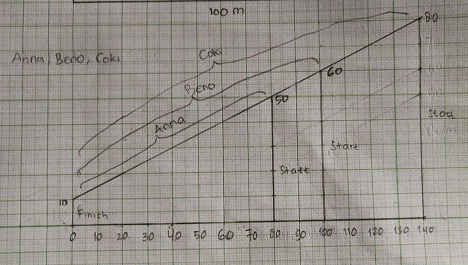
Copyright (c) 2022 Armiati Armiati, Ratih Permata Sari

This work is licensed under a Creative Commons Attribution-NonCommercial-ShareAlike 4.0 International License.
License and Copyright Agreement
By submitting a manuscript to Jurnal Pendidikan Matematika (JUPITEK), the author(s) certify and agree to the following terms:
- Originality and Authority: The submitting author is authorized by all co-authors to enter into this agreement. The manuscript describes original work that has not been published previously in a peer-reviewed journal, nor is it under consideration for publication elsewhere.
- Approval: Its publication has been approved by all author(s) and by the responsible authorities of the institutions where the work was carried out.
- Rights: The authors secure the right to reproduce any material that has already been published or copyrighted elsewhere.
- Licensing and Copyright: Authors retain the copyright to their work.
- License Grant: The authors grant Jurnal Pendidikan Matematika (JUPITEK) the right of first publication, with the work simultaneously licensed under the Creative Commons Attribution-NonCommercial-ShareAlike 4.0 International (CC BY-NC-SA 4.0).
- Self-Archiving: Authors are permitted and encouraged to deposit the published version of their article in institutional repositories, on their personal websites, and other academic platforms, with proper acknowledgment of its initial publication in Jurnal Pendidikan Matematika (JUPITEK).

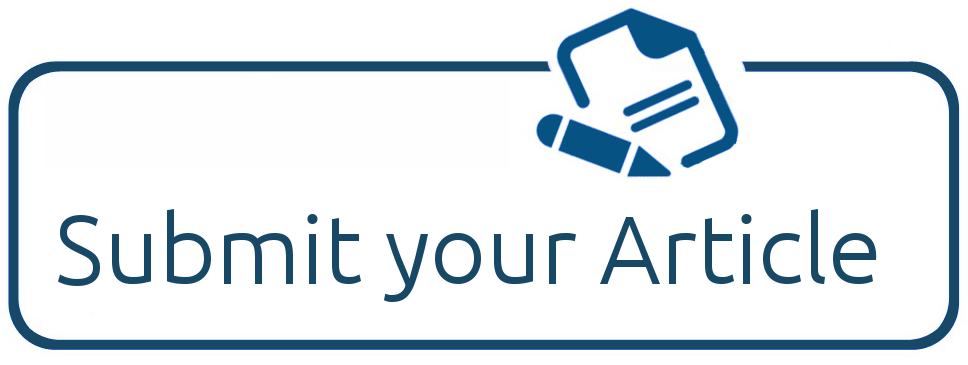
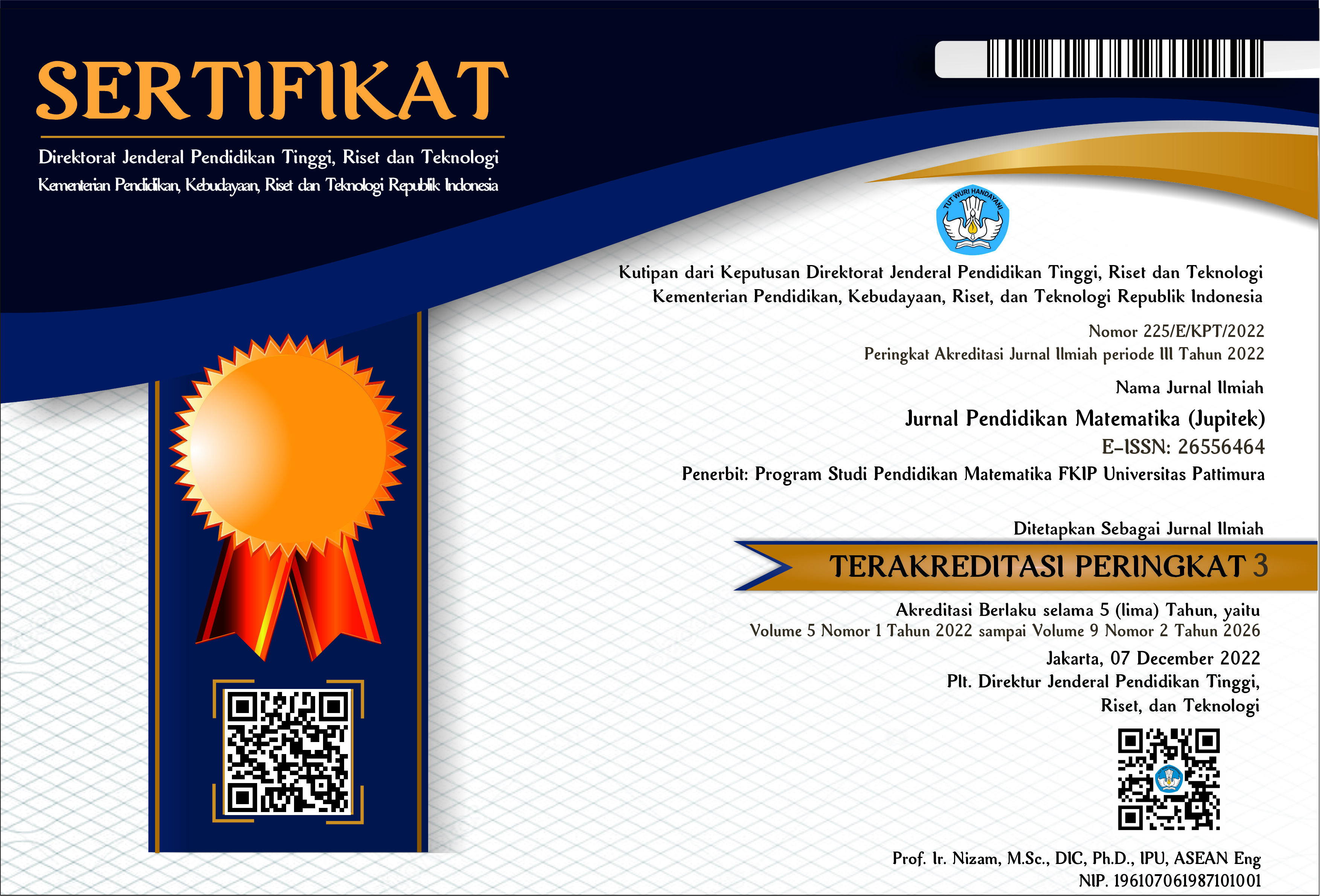

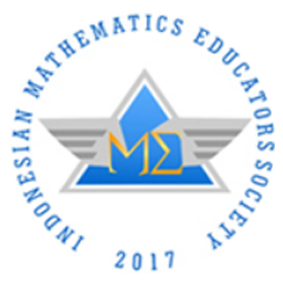
.png)
